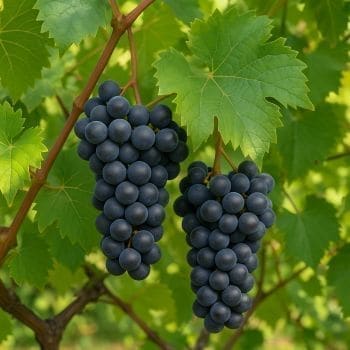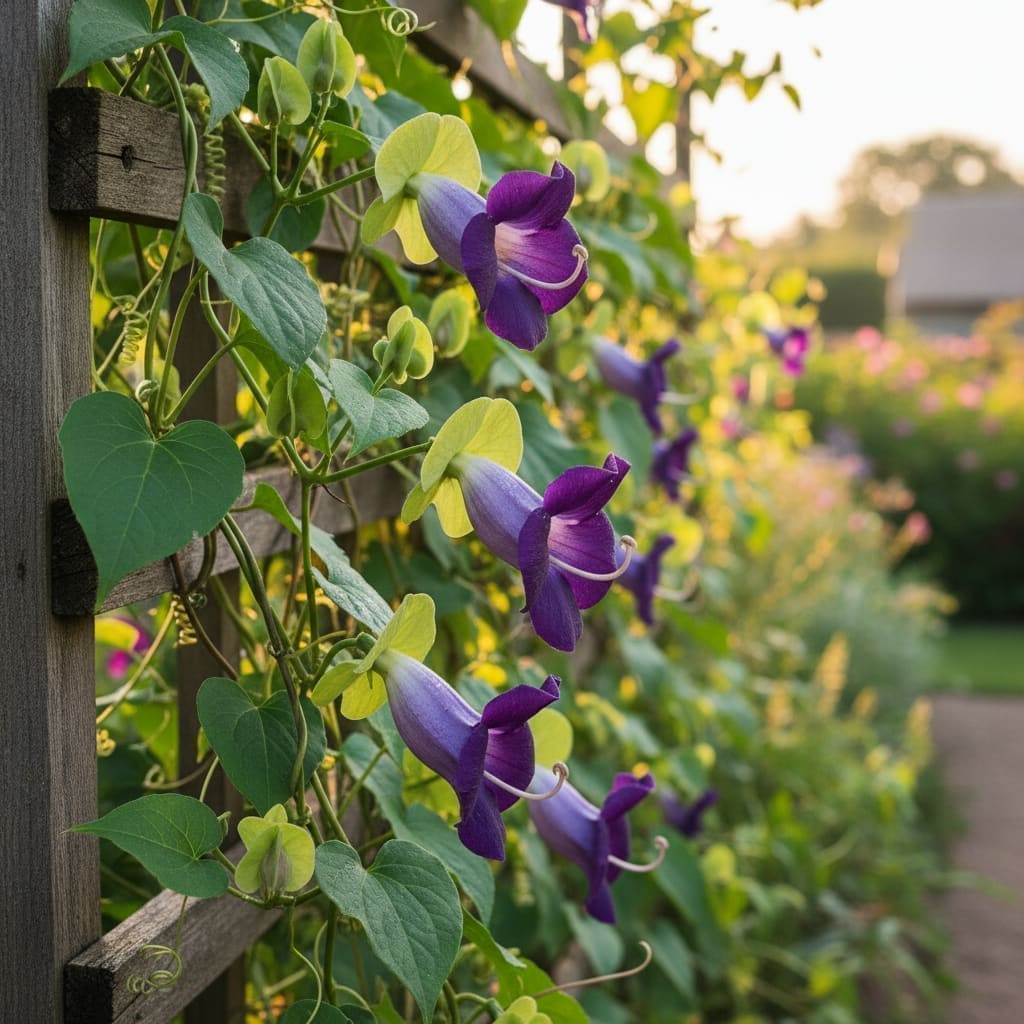Vitis vinifera (Common Grape Vine) Care & Growing Guide
Overview
Vitis vinifera, commonly known as the common grape vine, is a woody, perennial climbing plant native to the Mediterranean region, Central Europe, and Southwestern Asia. Cultivated for over 6,000 years, it is one of the oldest domesticated plants in human history, valued for its fruit, which is eaten fresh, dried, or fermented into wine. This species thrives in sunny, temperate climates and is a staple in vineyards worldwide.
In addition to its agricultural importance, Vitis vinifera can be trained decoratively along trellises, pergolas, or fences, providing both ornamental foliage and seasonal fruit.
Identification & Growth Habit
Vitis vinifera is a deciduous, climbing vine that uses tendrils to attach itself to supports. Mature vines can reach lengths of 30 feet (9 meters) or more if unpruned. The leaves are broad, lobed, and serrated, typically bright green in spring and summer, turning yellow in autumn. Clusters of small, greenish flowers appear in late spring, followed by bunches of grapes in summer or early autumn, depending on the variety and climate.
Growth is vigorous in favorable conditions, and without regular pruning, the plant can become tangled and less productive.
Light & Placement
Grapevines require bright, direct sunlight for optimal growth and fruit production. Outdoors, plant them in a location with full sun exposure for at least 6–8 hours daily. Indoors or in greenhouses, position near a south-facing window or supplement with high-intensity grow lights.
Good air circulation is essential to reduce the risk of fungal diseases, so avoid overly sheltered or stagnant air locations.
Watering & Humidity
Water moderately, keeping the soil evenly moist during the growing season. Allow the top inch of soil to dry slightly between waterings to prevent waterlogging. During droughts or dry indoor conditions, increase watering frequency while ensuring good drainage to avoid root rot.
Vitis vinifera prefers moderate humidity. Excess humidity can encourage fungal problems such as powdery mildew. If growing indoors, maintain airflow with fans or open windows, and consider using a dehumidifier in persistently damp environments.
Soil & Repotting
Plant in well-drained, loamy soil enriched with organic matter. A slightly acidic pH around 6.5 is ideal. Avoid heavy clay soils that retain excess moisture. For container-grown vines, use a large pot with drainage holes and a high-quality potting mix amended with compost.
Repotting is rarely needed for in-ground vines. Container vines may require repotting every 3–4 years to refresh the soil and accommodate root growth.
Fertilizing
Apply a balanced fertilizer in early spring before new growth begins. For young plants, provide an additional feeding about four weeks later. Spread fertilizer evenly 4–5 feet away from the vine’s base to prevent root burn. Avoid excessive nitrogen, which can promote leafy growth at the expense of fruit production.
Pruning & Training
Pruning is essential for controlling size, improving air circulation, and encouraging fruiting. In winter, during dormancy, remove dead or weak canes and thin out crowded growth. Train the vine along a trellis, arbor, or moss pole to support climbing and maximize sunlight exposure.
Common training systems include the Guyot and cordon methods, which help distribute fruiting canes evenly and make harvesting easier.
Propagation
Step-by-Step: Hardwood Cuttings (Dormant Season)
- Select healthy, mature canes from the previous season’s growth.
- Cut sections 8–12 inches long, each with at least two nodes.
- Remove any tendrils or leaves.
- Plant cuttings in moist, well-drained soil with the lower node buried.
- Keep soil consistently moist until roots develop, usually within a few weeks to months.
Step-by-Step: Softwood Cuttings (Active Growth)
- Choose young, flexible shoots in late spring or early summer.
- Cut 4–6 inch sections with two nodes.
- Remove lower leaves and dip the cut end in rooting hormone (optional).
- Plant in a well-draining propagation mix and keep in bright, indirect light.
- Maintain even moisture until rooted, then transplant carefully.
Common Problems
Pests
- Aphids – Control with insecticidal soap or a strong spray of water.
- Grape leafhoppers – Reduce populations with neem oil or horticultural oils.
- Spider mites – Increase air humidity slightly and use miticides if needed.
Diseases
- Powdery mildew – Improve air circulation, avoid overhead watering, and use fungicides if necessary.
- Downy mildew – Remove affected leaves and apply copper-based fungicides.
- Botrytis bunch rot – Thin fruit clusters and ensure good airflow.
Toxicity & Pet Safety
Warning: Grapes and grape products are toxic to dogs, cats, and some other animals. Ingestion can cause serious health issues. Keep plants and fallen fruit out of reach of pets.
Styling & Decor Tips
Train Vitis vinifera over pergolas or trellises to create shaded seating areas in gardens. In containers, use a sturdy support to showcase its climbing habit. When in fruit, the hanging grape clusters add a striking, edible ornamental element to patios and balconies.
Varieties & Cultivars
There are thousands of Vitis vinifera cultivars, bred for table grapes, raisins, or wine production. Popular examples include:
- ‘Thompson Seedless’ – Common for fresh eating and raisins.
- ‘Cabernet Sauvignon’ – Widely grown for red wine.
- ‘Chardonnay’ – A leading white wine grape.
- ‘Concord’ – Known for juice and jelly (note: Concord is actually Vitis labrusca, often confused with V. vinifera).
Buying Tips & Maturity
When purchasing grapevines, choose certified disease-free stock from reputable nurseries. Inspect for healthy, well-developed roots and no signs of pests or damage. Vines typically begin producing small crops in their third year, with full production reached after 5–7 years under good care.
Seasonal Care
- Spring: Fertilize, train new shoots, and monitor for pests.
- Summer: Maintain watering, thin fruit clusters, and prune excess foliage for airflow.
- Autumn: Harvest grapes when fully ripe; remove any diseased plant material.
- Winter: Prune during dormancy; protect young vines from frost with mulch or coverings in colder regions.
FAQ
How much sun does Vitis vinifera need?
It requires full sun—at least 6–8 hours of direct light daily—for healthy growth and fruiting.
Can I grow grapevines indoors?
Yes, if provided with strong direct light or grow lights, ample space, and good air circulation. Indoor fruiting may be limited compared to outdoor growth.
When will my grapevine produce fruit?
Most vines begin producing small harvests in their third year, with peak yields after 5–7 years.
How do I prevent powdery mildew?
Ensure good airflow, avoid overhead watering, and prune to reduce dense foliage. Fungicides may be used preventively in high-risk climates.
Is Vitis vinifera frost-hardy?
No, it is not frost-hardy. Protect vines from freezing temperatures, especially young plants.
Sources: Wikipedia, The Spruce






